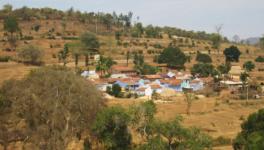Modi Govt Clears Way for Residential Units in Reserved Forests
Representational use only.
New Delhi: Notwithstanding the fact that rights of forest-dwelling communities of the country are yet to be settled despite directions of the Supreme Court of India, the Modi government has tweaked environmental laws to allow diversion of forest land for building residential projects. The move also comes at a time when the Union government has admitted that massive tracts of forest land across the country are already under encroachment.
On January 24, the Union Ministry of Environment, Forests & Climate Change (MoEFCC) issued guidelines whereby “in exceptional circumstances” forest land can be considered for diversion for residential projects of up to 1 hectare in area. The ministry issued this through an office order to clarify existing Scheduled Tribes and Other Traditional Forest Dwellers (Recognition of Forest Rights Act), 2006 – known popularly as Forest Rights Act, 2006.
But the Union government's interpretation of the existing guidelines was issued without seeking consultation with any of the stakeholders and bypassing the Parliament, which met barely a week later for the budget session. The guidelines were issued on the advice of the Forest Advisory Committee (FAC), an expert panel under the ministry empowered with the responsibility to appraise infrastructure projects that involve the diversion of forest land.
The ministry has not defined the term “exceptional circumstances” in the order. The order, however, says that the concurrence of the respective state government and the ministry’s regional office in that state is required for approval to divert forest land for residential projects. Questions have begun to be raised on the very objective of the policy in the light of the events last year in Khori Gaon on the outskirts of Delhi in the BJP-ruled state of Haryana, where a demolition drive was undertaken to raze nearly 10,000 dwelling units belonging to the working class but luxurious farmhouses belonging to the uber-rich are yet to be pulled down. The shanties, as well as the farmhouses, were both constructed illegally on forest land.
"The latest policy decision is extraordinary since it has been announced by the ministry that is entrusted to protect forests of the country. The policy can open up floodgates for real estate in the pristine forests of the country. Who will the policy benefit?" asks Debi Goenka of the Mumbai-based Conservation Action Trust, an organization working in the field of wildlife and forestry. "Diversion of forest land should only be allowed for site-specific projects like mines or dams where an alternative site is not possible. This policy decision further has the potential to set up a precedent for approval of non-site specific projects," he added.
State governments, irrespective of the ideologies of their ruling political parties, are themselves lagging behind settling rights of individuals and communities who have been living on forest lands for generations. Yet, as per experts, the doors have been opened up for the affluent for residential projects in forest land.
The Forest Rights Act, 2006 recognizes the rights of traditional dwellers, other than Scheduled Tribes, who have been living in forest land or dependent on it for their livelihood for at least three generations or 75 years. After more than 15 years of enacting the Act by the Congress-led UPA government, millions of applications for forest rights by both individuals and communities are either pending or have been wrongfully rejected. As of February 2022, only 48% of forest right claims have been granted across the country – rejections account for a massive 38%, while 14% of claims are also pending disposal.
The delay in settlement of forest rights claims of the marginalized sections has not only been marred by divergent methods for screening applications adopted by various state governments but also by the reluctance of the Union Tribal Affairs Ministry to play a nodal role in the process. In February 2019, a three-judge bench of the Supreme Court headed by Justice Arun Mishra had directed state governments to review individual and community claims over forest land that have already been rejected.
“While state governments have delayed implementation of the Forest Rights Act, they have also failed to prohibit encroachment upon forest lands. Massive tracts of forest land are continuously being encroached upon by the land mafia, which has led to degradation of ecology and fragmentation of wildlife habitats,” said Bhubaneshwar-based independent researcher Tushar Dash.
In a written response tabled in the Rajya Sabha during the budget session of Parliament in February, the MoEFCC has provided state-wise details of areas of reserve forest land under encroachment in India. Madhya Pradesh topped the list with almost 54,173 hectares of reserve forest land under encroachment, followed by Arunachal Pradesh, where over 53,450 hectares have encroached. Significant areas of forest land are also under encroachment in Odisha (33,154 ha), Jharkhand (29,048 ha) and Andhra Pradesh (34,358 ha).
“Through issuing an office order, the government is stealthily adopting a backdoor method to divert forest land for trivial purposes which it could not accomplish by way of a legislative process that it had initiated last year by inviting consultations on proposed amendments to the Act. Civil society and forest conservation groups had vehemently opposed the proposed amendments,” added Dash.
Last year, the ministry had proposed amendments to exempt several non-forestry activities, including defence and security-related projects along the country’s international border, zoos, forest training infrastructure, and surveys and investigations on forest land from the purview of FCA, 1980.
Experts argue allowing approval for residential projects under Forest (Conservation) Act, 1980 would be equivalent to further opening up ecologically fragile areas to land sharks. The recommendation to modify forest conservation guidelines favouring residential projects was given to MoEFCC by senior forest department officials on board the Forest Advisory Committee during a meeting held in September 2021.
“The justification in allowing residential projects on forest lands can certainly be questioned though the government can make changes to or issue clarifications to guidelines through office orders. Again, the Forest Advisory Committee can advise the central government on any matter regarding the conservation of forests that is referred to it. However, the interpretation of the guidelines, in the first place, is regressive in nature. A recommendation of this nature cannot be made because it goes against the Forest Conservation Act and forest conservation policy, which do not permit non-site specific activities on forest land,” said environmental lawyer Rahul Chaudhary.
As per experts, therefore, the central government’s interpretation of the guidelines is flawed. It hinders the very objective of the Forest (Conservation) Act, 1980, which is to ensure "conservation" of forests by restricting non-forest activities in forest areas.
“These guidelines may give the impression that they are directed at forest conservation. However, there is a need to review its fundamental premise. Firstly, the Forest Conservation Act does not prohibit activities but regulates them to permit land-use change based on prior assessments. So, each proposal needs to be reviewed on its merits rather than unjustified assumption such as one hectare for residential purposes as has been proposed,” Kanchi Kohli of the Delhi-based think-tank Centre for Policy Research told NewsClick.
But the ministry also made it clear through the clarified guidelines issued on January 24 that non-site specific activities – utilization of forest areas for establishing industries, construction of residential colonies, institutes, disposal of fly ash, rehabilitation of displaced persons – cannot be considered on forest land as a rule.
“Equating the need for resettlement of displaced persons and fly-ash disposal or industrial activities is fundamentally flawed. Displacement is the result of power exercised by the state and not a choice by the people who have to give up homes, land and livelihoods. Forty years after its existence, the forest conservation act needs to start reflecting its intent and embrace the idea of humanitarian conservation,” added Kohli.
The writer is an independent journalist.
Get the latest reports & analysis with people's perspective on Protests, movements & deep analytical videos, discussions of the current affairs in your Telegram app. Subscribe to NewsClick's Telegram channel & get Real-Time updates on stories, as they get published on our website.
























